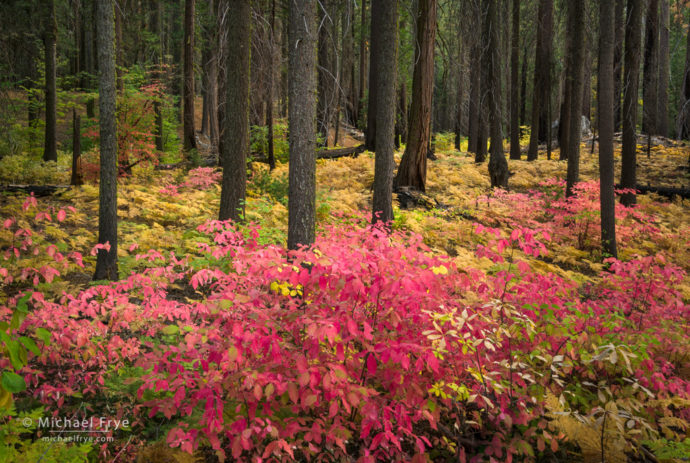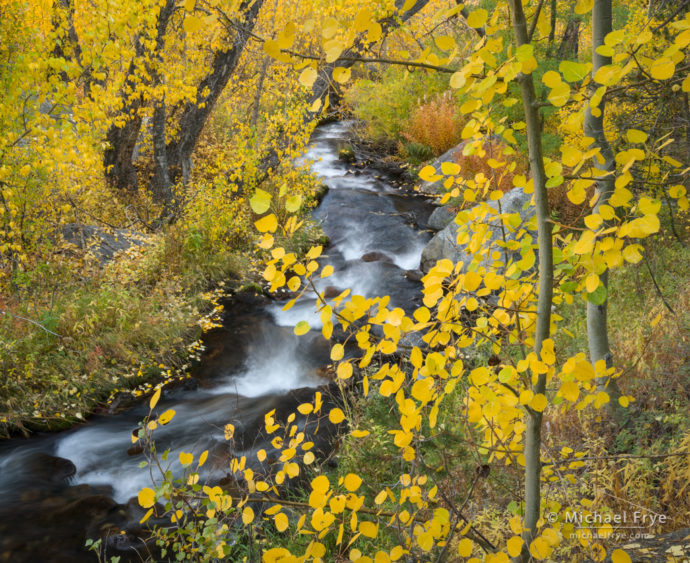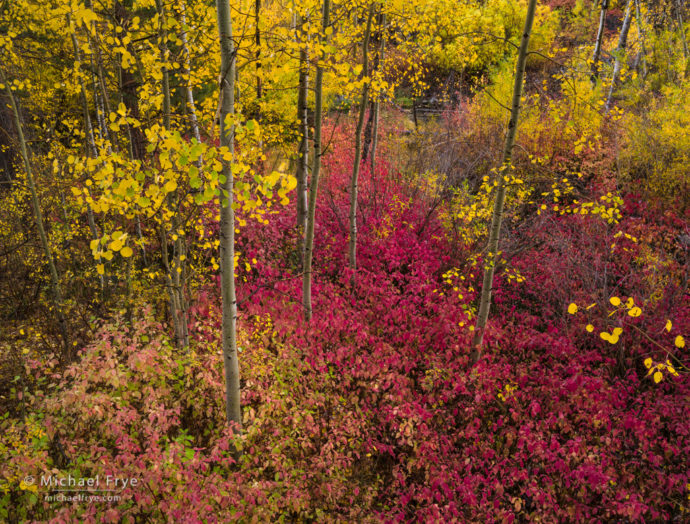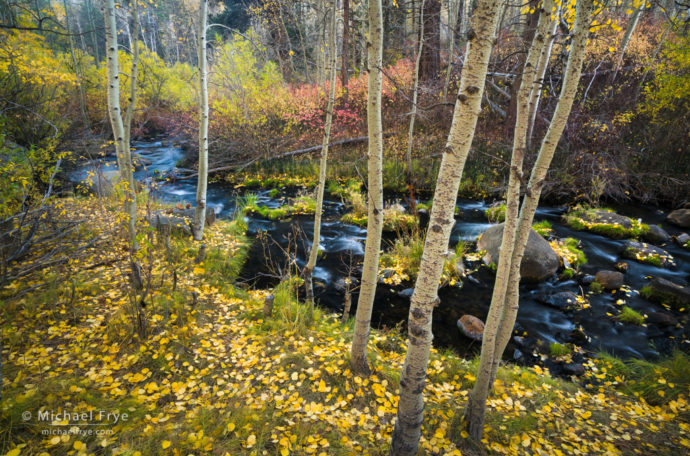
Autumn forest with dogwoods and ferns, Yosemite, October 13th. I stood on a log to see over the foreground dogwoods and into the forest; the focal length was 35mm.
I’ve made many images of intimate landscapes over the years, and the vast majority of them were taken with a telephoto lens (usually my 70-200mm zoom). It makes sense to use a lens with a narrower angle of view when focusing on a small piece of the landscape and trying to eliminate clutter in complex forest scenes. Telephoto lenses are also great for compressing space and emphasizing patterns – typically key components of intimate landscapes.
But lately I’ve found myself using wide-angle lenses more and more for smaller scenes. Part of the impetus for this was just buying a new lens. This past July I purchased a new wide-angle zoom (the Sony Vario-Tessar FE 16-35mm f/4 ZA OSS), and it’s natural to want to use and test a new piece of equipment, so I started pulling this lens out in many situations just to see what it could do. But another part of the impetus was just the desire to do something different. I’ve had plenty of practice composing intimate landscapes with telephoto lenses, and I wanted to force myself to look at these scenes in a new way.
Of course there are some obvious challenges when using wide-angle lenses with smaller scenes. The wide field of view makes it easy to include extraneous stuff that creates clutter. In other words, it’s harder to make strong, clean, simple compositions when the focal length dictates that you include a relatively large piece of the landscape. And for forest scenes, where the best light is usually overcast or shade, it’s important to keep the sky out of the frame, otherwise that bright sky becomes an eye-pulling distraction. Keeping the sky out of a composition with a wide-angle lens is challenging; you have to point the camera down, and look for situations where you’re shooting toward a hill or ridge rather than toward an open view of the sky. It also helps to find a higher vantage point so you can look down, out, and over the forest floor.
But despite these challenges I’ve come to appreciate the wide-angle perspective with intimate landscapes. The wider field of view helps create a stronger sense of depth, making the viewer feel immersed in the scene, and that immersion can lead to a stronger emotional connection with the photograph.
Of course I still frequently use telephoto lenses with intimate landscapes. I’m looking for the best composition – the framing that will tell the visual story in the strongest way – and pick the tool appropriate for the task. Sometimes that means using a wide-angle lens, and sometimes that means using a telephoto lens. All that’s really happened is that I’ve expanded my visual repertoire a bit, and found more situations where I can tell that story with a wide-angle lens. It’s always good to expand your visual horizons. The more tools at your disposal, the easier it becomes to find the right tool for the situation at hand.
— Michael Frye
P.S. I’ve included some recent examples in this post, but I’ve posted many other photographs lately showing wide-angle views of intimate scenes, including here, here, here, and here.

Autumn colors along Bishop Creek, Inyo NF, October 1st. Another elevated perch – this time on a rock – helped reveal the s-curve in the creek, and allowed me to point the camera down and keep the sky out of the frame. The focal length was 35mm.

Aspens and dogwoods, autumn, Inyo NF, October 14th. I climbed onto a boulder to get this high vantage point, allowing me to point the camera down into the forest to show the colorful understory. The focal length was 26mm.

Autumn scene along an eastern Sierra creek, Inyo NF, October 18th. This camera position was slightly elevated, as the ground sloped more steeply up from the creek than it looks in the photo. The wide-angle lens (18mm) allowed me to include the curving line of the creek, which helped to convey a sense of depth.
Related Posts: A Beautiful Autumn Day in Yosemite; Autumn on the East Side
Michael Frye is a professional photographer specializing in landscapes and nature. He is the author or principal photographer of The Photographer’s Guide to Yosemite, Yosemite Meditations, Yosemite Meditations for Women, Yosemite Meditations for Adventurers, and Digital Landscape Photography: In the Footsteps of Ansel Adams and the Great Masters. He has also written three eBooks: Light & Land: Landscapes in the Digital Darkroom, Exposure for Outdoor Photography, and Landscapes in Lightroom: The Essential Step-by-Step Guide. Michael has written numerous magazine articles on the art and technique of photography, and his images have been published in over thirty countries around the world. Michael has lived either in or near Yosemite National Park since 1983, currently residing just outside the park in Mariposa, California.









Very beautiful Michael! I love my 16-35 Sony lens too although I haven’t done too many intimate shots so thank you for the inspiration to go out and try some!
Thank you Laura!
I’ve been debating whether to go with a telephoto or wide angle lens for a new grain elevator project I’m working on. After reading this, I’m still undecided about which way to go for the project, but I’m definitely pulling out the wide angle lens more often in other situations! Thanks for the valuable point of view!
Michael, very nice perspective on intimate landscapes. I sometimes have used this technique in some ravines when back in Ohio, but I had not tried the more elevated camera angle which certainly makes a difference. Most of my shots are more CUWA-like from low angles. Looking at your “Aspens and Dogwoods” image almost made me think it was taken from a drone!
Wonderful shots and info. I tend to notice that when my mind is quiet and my personal life is more in tune, and when in on time and early for a shoot… it reflects in my disapline behind the camera. Wide or tele, it’s me who has to make the choice I suppose. Do I really want to snap this. When I’m rushing or frantic, clutter and distractions seem to show up in my frame. Funny how that works huh. Art reflects life. Flipping through a few gigs of messy shots is always s great teacher too 🙂 I adimire the disapline in these shots mike, great stuff.
Thanks Mizz. You bring up a great point, because I think most people make better photographs when they’re calm and focused. Technical proficiency is one thing – an important thing – but you also need to be able to tune in to your surroundings and really see what’s around you.
As always, I find this article and photographs informative and clearly explained. Thanks for the post.
Thanks Kearnes!